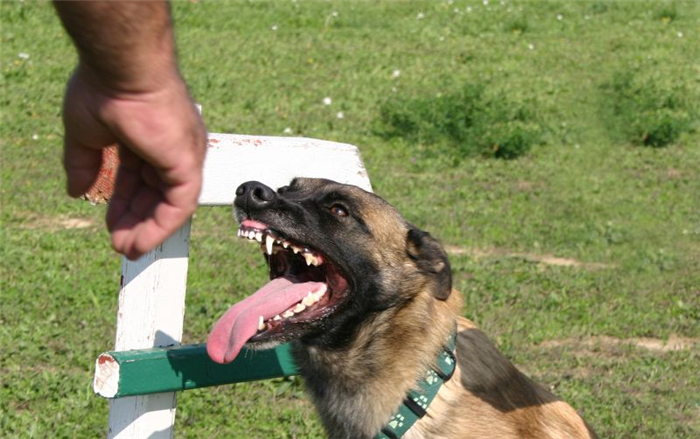This blog will explain the causes of sudden aggression in dogs, how to spot the warning signals, and the best strategies for controlling and averting violent outbursts.

1. Understanding the Triggers Behind Sudden Aggression
Dogs become aggressive sometimes for reasons other than dominance or bad behavior, and other factors can play a role, such as fear, pain, territorial instincts, and sometimes medical conditions that exist beneath the surface. Determining the precise origin of aggression is very important for controlling aggression in dogs.
- Pain or illness –If a dog suddenly turns aggressive, it could well have an unexposed injury or be suffering from some disease. For example, diseases like arthritis, infections, or neurological diseases could lead to unexpected aggressive behavior in such dogs.
- Fear-based aggression – Triggers of this type of aggression include traumatic experiences, some loud noise, or even strangers.
- Possessive aggression – A dog could keep guarding its food, its toys, or even a human being, hence declaring sudden aggressiveness.
- Frustration aggression –A dog may snap out at its controller in frustration because it is tied down from where it wants to reach or it can't put its paws on something it wants.
The first step in addressing aggressive behavior is to recognize the triggers.
2. Recognizing Aggression Signals in Dogs Before It Escalates
It's rare for dogs to attack unexpectedly. Before acting aggressively, they communicate their uneasiness through vocalizations and body language. Recognizing aggression signals in dogs might help avoid unexpected outbursts.
- Growling and snarling – Snarling and growling are obvious indicators when a dog is uneasy or feels threatened.
- Rigid body posture –A dog is probably getting ready to respond if its body tenses up and it looks at you intently.
- Raised hackles –When the fur on the back stands up, it signifies increased stress or hostility.
- Pinned-back ears and bared teeth – Bare teeth and pinned ears are indicators of defensive hostility or fear.
- Lip licking and yawning – Often disregarded, lip-licking and yawning are indicators of stress that, if ignored, might escalate into violence.
Owners can take action before aggression becomes a significant issue by identifying these early warning indicators.
3. Controlling Aggression in Dogs Through Training and Socialization
Techniques for consistent training and positive reinforcement can aid in behavior modification once aggression has been discovered. Here's a safe and efficient method for managing aggression in dogs:
- Establish Leadership – Dogs require rules that are consistent and have defined boundaries. Being a calm and self-assured leader calms them down and lessens their aggression.
- Desensitization & Counterconditioning – By carefully introducing triggers to dogs over time, you can help them form constructive associations rather than hostile responses.
- Redirect Aggression –Use orders, toys, or incentives to divert a dog's attention when it growls rather than penalize it. It learns different coping mechanisms from this.
- Controlled Socialization – Positively introducing dogs to new people, animals, and situations helps avoid fear-based aggressiveness.
- Professional Training –Seeking advice from a qualified dog behaviorist might offer tailored tactics if aggressiveness continues.
With patience and the proper techniques, even the most aggressive dogs can learn to react calmly in stressful situations.
4. When Medical Issues Are the Cause of Sudden Aggression
All aggressive behavior is not manifested; sometimes, it is a medical condition. Sudden aggressiveness in dogs may be due to pain, neurological disorders, or changes in their hormonal levels. A vet check-up is mandated when an ordinarily friendly dog suddenly becomes aggressive.
- Thyroid disorders –Sudden aggression or irritability occurs due to an imbalance of thyroid hormones.
- Chronic pain – Just arthritis, dental pain, or even internal injury can cause a simple, gentle dog to be aggressive when touched.
- Cognitive dysfunction –Older dogs stricken with dementia may get confused and exhibit aggressive behavior.
- Neurological issues – Brain tumors or seizures can bring an unexpected change in a dog's behavior.
It is essential to rule out any medical causes before trying to apply any behavioral training.
5. Creating a Safe Environment to Prevent Aggression
The first step in preventing aggression in dogs is to give them a secure, orderly, and stress-free environment.
- Routine & Predictability – Regularity and predictability are essential for dogs. Uncertain surroundings may cause them to become agitated and more likely to react violently.
- Exercise & Mental Stimulation – A happy dog is a tired dog. Frequent games, puzzle toys, and walks help burn off extra energy and lessen violence based on frustration.
- Safe Spaces – You can stop defensive aggressiveness in dogs by providing them with a calm, secure area to go to when they feel overstimulated.
- Supervised Interactions – Always keep an eye on encounters with new individuals or dogs to avoid territorial confrontations.
Owners can lessen the chance of aggressive outbursts by making small changes to the home that make dogs feel safe.
Conclusion: Regain Control and Build Trust
Although handling a dog's unexpected aggression might be frightening, aggressive behavior can be controlled and even completely eradicated with the correct strategy, patience, and perseverance. In order to regulate sudden aggression in dogs, it is crucial to comprehend triggers, identify early signs of aggression, and use appropriate training methods.
Take action right away if your dog has been acting erratically. Watch, practice, and, if needed, get expert assistance. You can turn even the most temperamental dog into a peaceful and well-behaved friend by cultivating stability and trust. Aggression doesn't have to be permanent.
Growls will cease to exist with the proper treatment, leaving only wagging tails and a calm relationship between you and your dog.